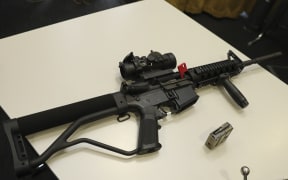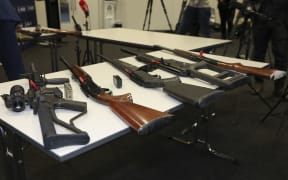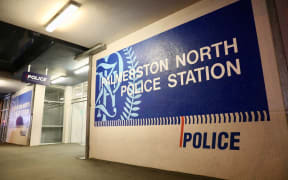In the days following the Christchurch terror attacks, politicians rushing to pass new laws mistakenly agreed to ban magazines for all firearms.

A selection of firearms which are now prohibited, on display to media at a police press conference. Photo: RNZ / Ana Tovey
A briefing from police was sent to the Prime Minister, Jacinda Ardern, and her Cabinet colleagues on 19 March, making a number of proposals for amendments to the Arms Act, 1983.
The briefing, obtained under the Official Information Act, states that Cabinet had agreed in principle to "ban detachable magazines for firearms other than 0.22 calibre, ban all magazines capable of holding more than 10 rounds, and ban magazines for shotguns capable of holding more than 5 rounds".
In response, police made a number of changes to the proposals, including a key change to the magazines that would be banned.
"We refined the description of 'the magazine' agreed to in the principle recommendations as this would have mistakenly banned all magazines, including those of pistols."
Police also refined the definition about what type of pump-action shotguns should be excluded from the ban and specified that A-category, rimfire 0.22 calibre or less rifles should be exempt.
Critics of the firearms law changes said the process was too rushed, and not enough time was given for submissions on the amendments to the act.
The documents show some early errors were picked up by police, while other concerns were dealt with when the bill was brought to Parliament less than two weeks later.
Police said that once semi-automatic firearms were reclassified as military-style semi-automatics, A-category owners would have a number of options available to them.
They could give up the gun during the amnesty, hand the gun in for police to hold until the gun buy-back initiative took effect, or sell or give the gun to someone with an E-category licence.
A fourth option was that police would hold onto the gun while the owner applied for an E-category endorsement.
"Police has no estimate of the number of firearm holders who will apply for an E Category licence," the report said.
"Any that are provided for storage whilst an E endorsement is sought cannot be destroyed, but would be retained until such time as the endorsement is provided".
Because a ban was put in place, guns will be destroyed instead.
Cabinet also asked for police to report back about whether collectors should be made exempt from the ban, a move that was added to the legislation when it was approved in April.
Police said that "additional staff will be required and will be engaged on fixed-term contracts" during the buy-back scheme.
They noted the Defence Force would provide assistance in the movement and secure storage of firearms, but police would oversee the physical destruction of firearms.
The report also showed how little police knew about the number of firearms that would need to be seized.
It said there were 244,608 firearms licence holders as at 30 September 2018. Of those, 7460 had an E endorsement.
As of March 2019, 13,471 E-category firearms were in circulation.
Police still do not know how many now banned guns there are in New Zealand.






